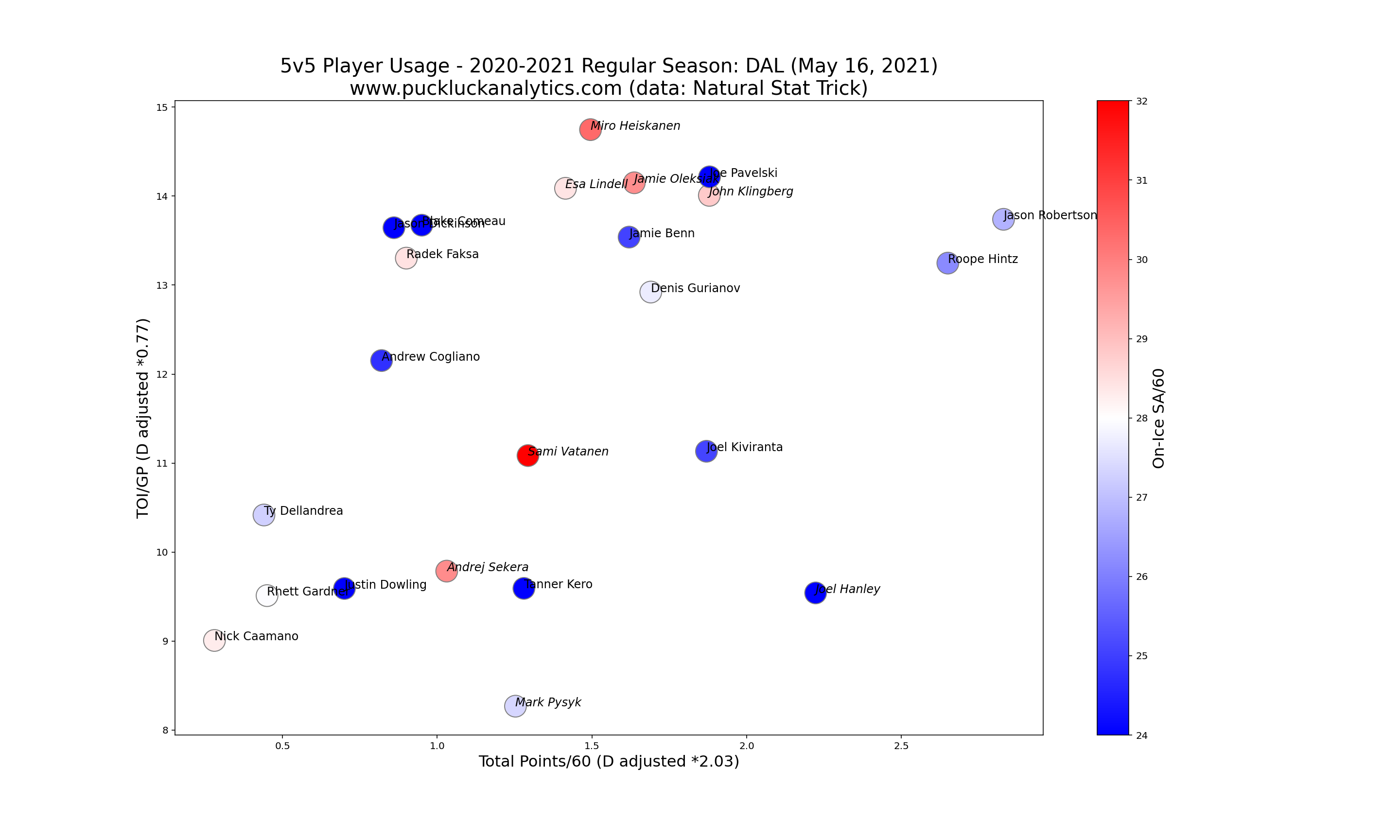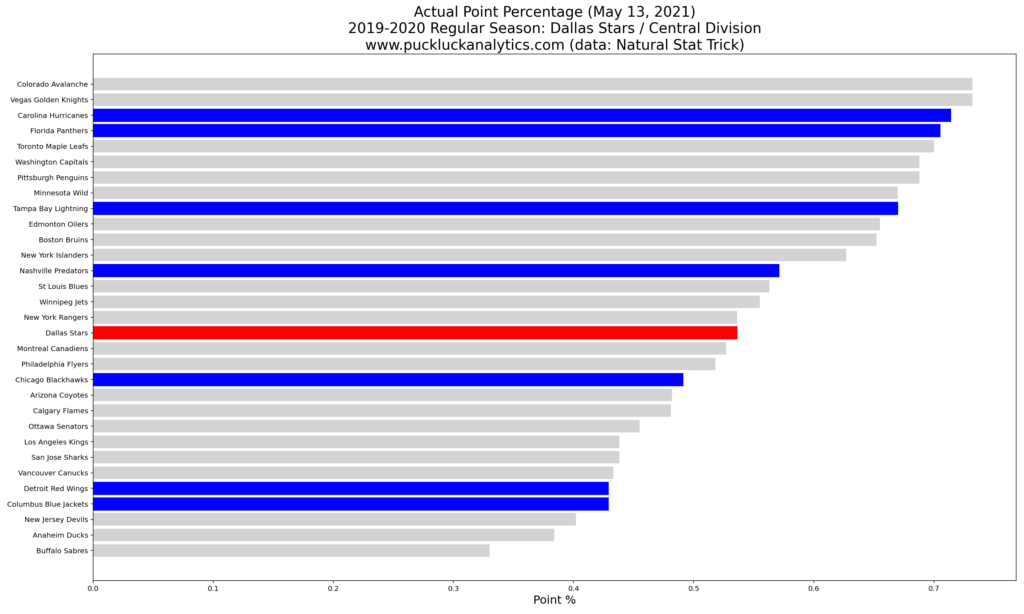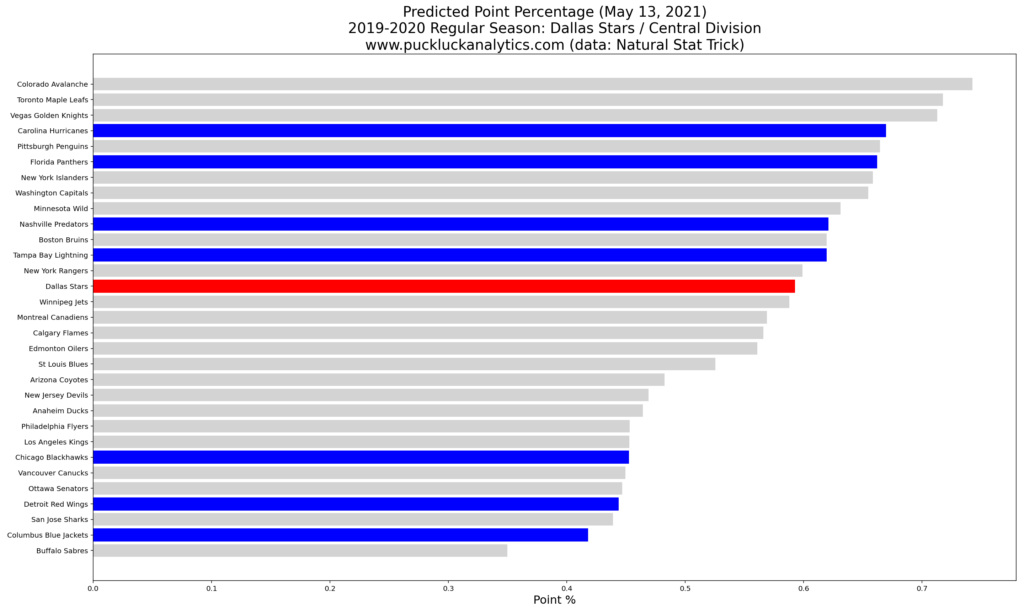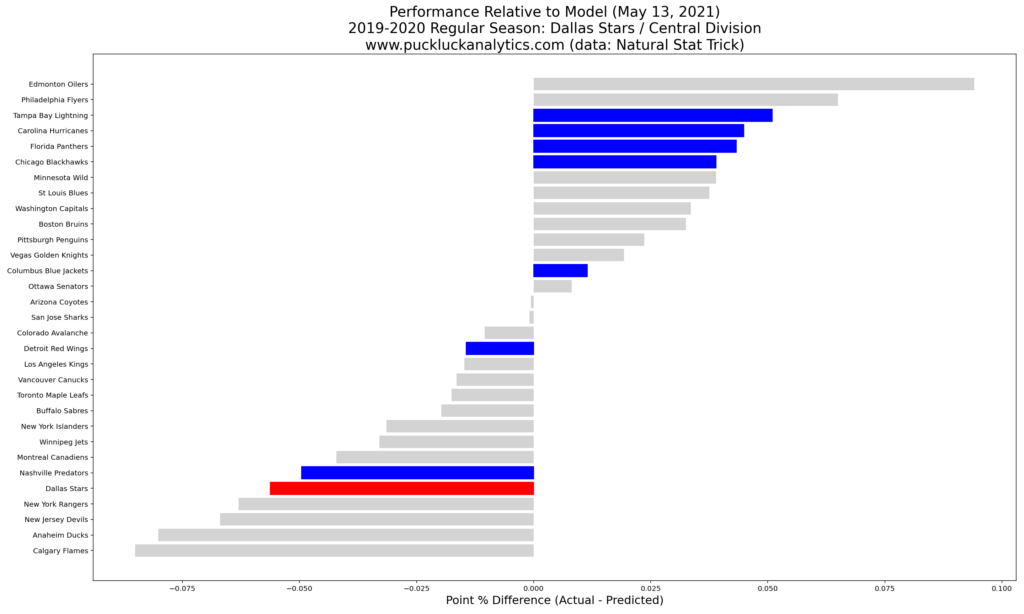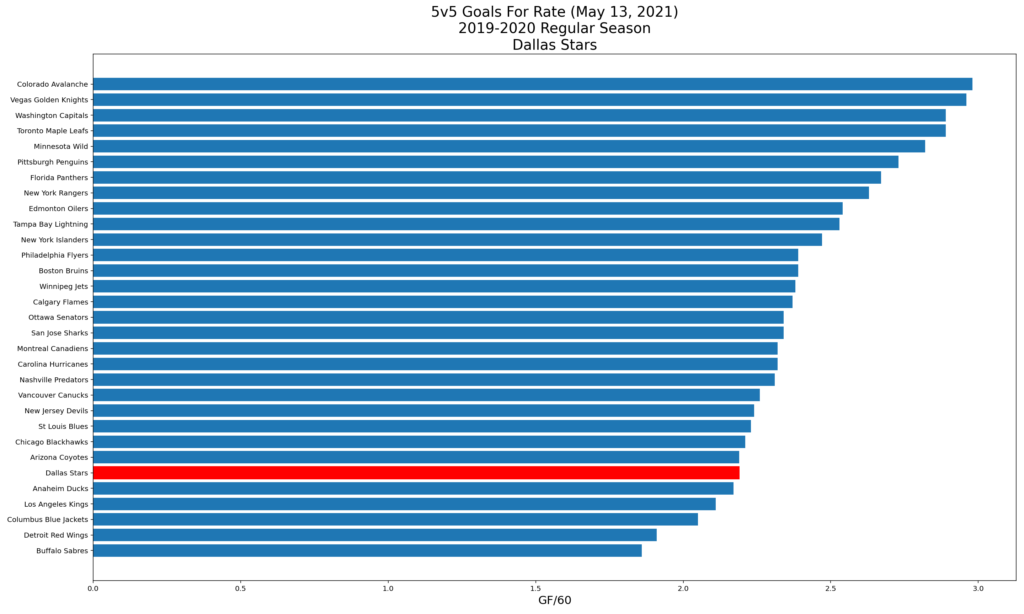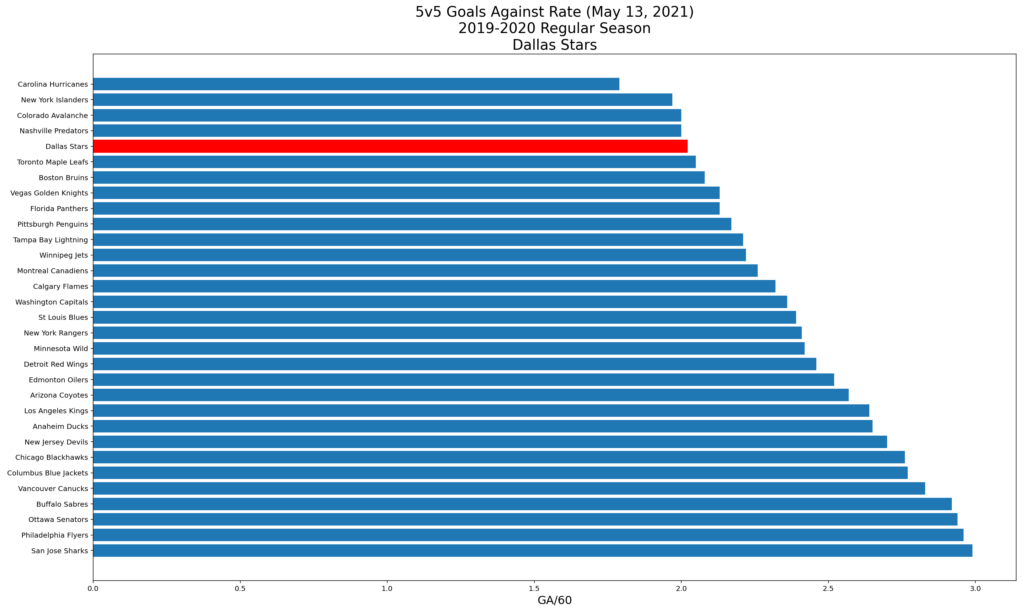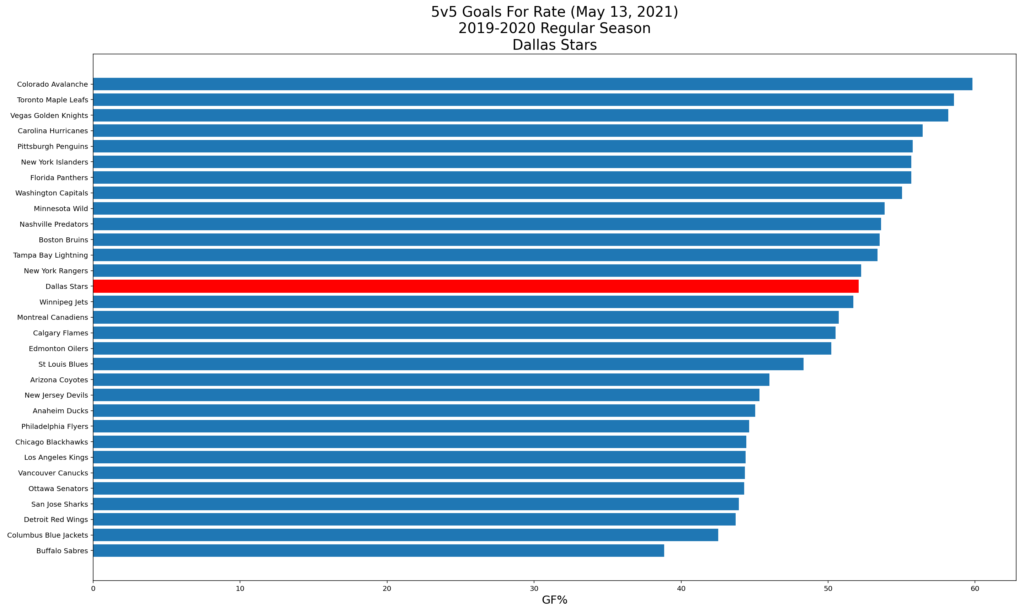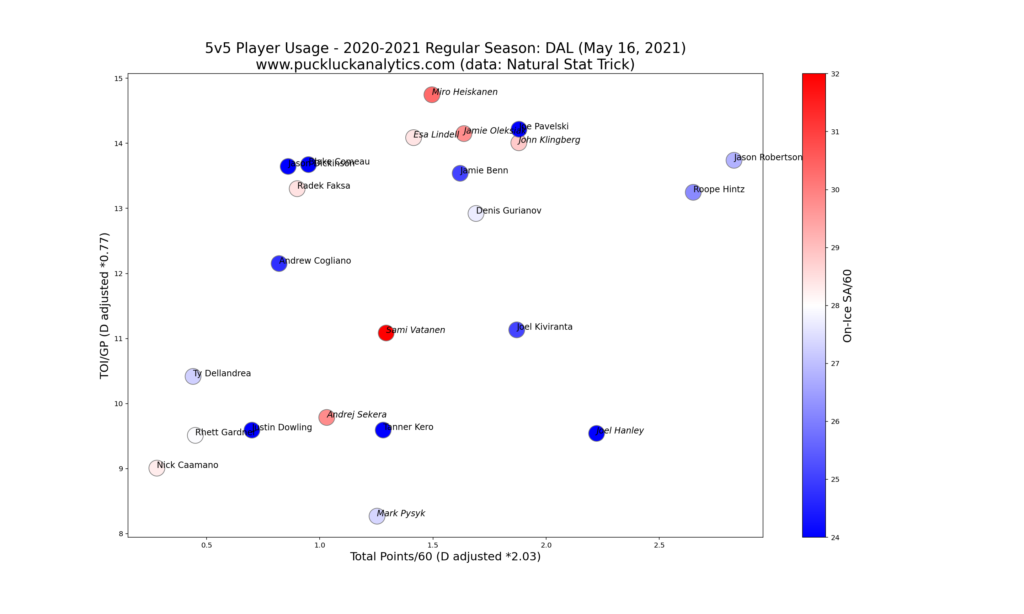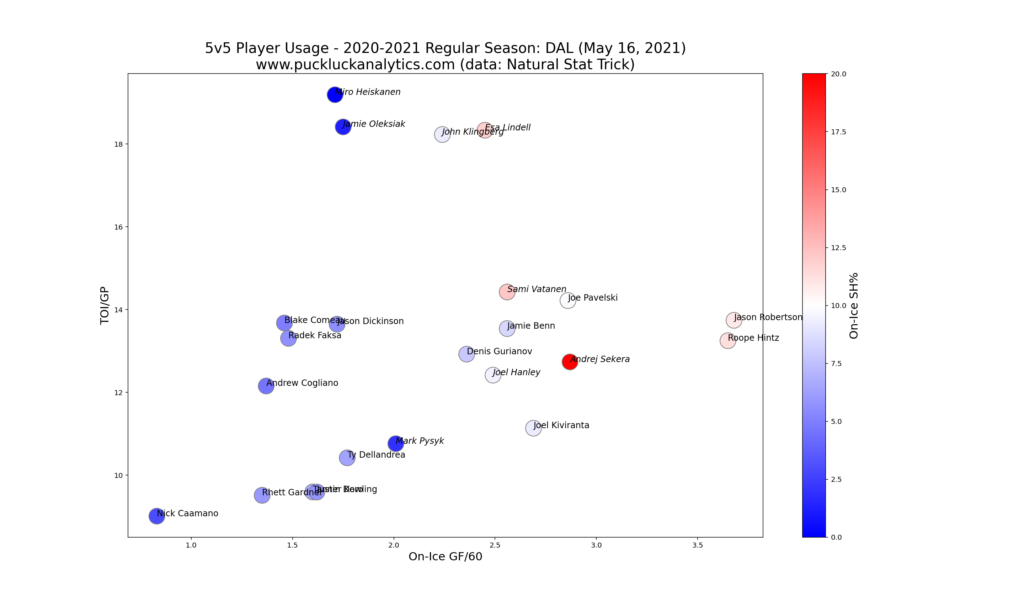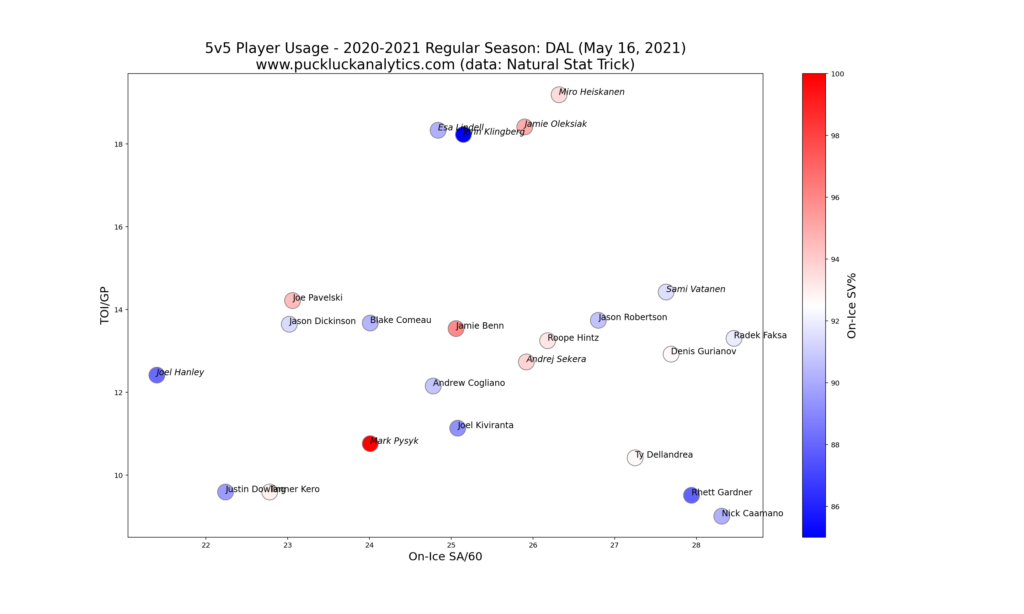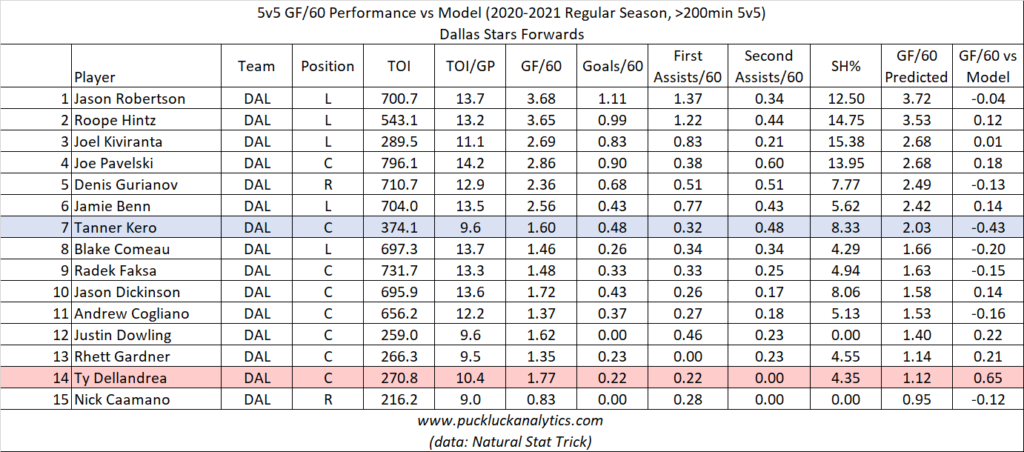Following a run to the Stanley Cup Finals in the 2020 playoffs, the Dallas Stars failed to make the playoffs in 2020-2021. With a Covid outbreak and some key injuries taking their toll, where do the Stars need to improve this offseason? We’ll dig into this question in my Dallas Stars season review. I encourage you to check out this post for more detail on what I’m looking for in the plots.
Overall Performance
While the Stars were well back in the standings for much of the early part of the season, it was primarily due to number of games played after a Covid outbreak delayed the start of their season. They hovered close to the playoffs based on point percentage for much of the season but ultimately couldn’t catch the Nashville Predators for the final spot in the Central.
Taking a look at our points predictor model relative to the Stars actual results, we see that they underperformed the model significantly. The model uses 5v5 goal rates as input so this suggests that the Stars were somewhat unlucky this year in the way the standings played out. Overtime results look like the biggest factor for the Stars. They went 5-14 in OT, which includes a 2-6 record in shoot-outs. While the model still puts the Stars in 5th in the Central, this is a positive sign looking to next season.
We’ll also take a look at the 5v5 goal rates used by the points predictor model.
The Stars strong defense propelled them on their long playoff run last season and it remains a strength. Their 5v5 defense was top 5 in the NHL this season. Generating 5v5 offense was where the Stars struggled, which was exacerbated by long term injuries to Tyler Seguin and Alexander Radulov.
Player Performance
Looking at a 5v5 player usage chart with defensemen’s stats adjusted for comparison with forwards give us a visual depth chart. The top players appear at the top right and we should see players distributed along the diagonal down to the bottom left.
The Stars players are spread quite widely away from the diagonal line we expected, suggesting player utilization wasn’t optimal this season. It looks like the Stars over-utilized the top half of their lineup, which may have been a result of their search for more offense. We can also see the emergence of Roope Hintz and rookie Jason Robertson as the Stars offensive leaders this season.
We get a visual depiction of the relative impacts on team GF/60 by plotting on-ice GF/50 vs TOI/GP. Players further toward to the top right had greater contributions to team offense.
Again, we see Robertson and Hintz at the far right on this chart. With their ice-time comparable to many other forwards on the roster, it looks like their overall impact could have been greater if they were provided a bit more opportunity.
On defense, we see the Stars’ top 4 grouped relatively closely, which indicates they had relatively stable offensive support from the back end.
Now, let’s look at defensive impact by plotting on-ice SA/60 vs TOI/GP. This gives us a similar visual for contributions to team GA/60 for skaters.
The Stars clearly have a defensively sound system that their players have bought into. The league average for 5v5 on-ice SA/60 among players with at least 200 minutes played is 30. The Stars don’t have a single player over that mark.
Switching focus to our GF/60 models, we’ll look for variances from the model greater than about 0.3. Negative variances suggest a player carried his line mates. Let’s start with the forwards.
The thing that stands out the most with the Stars forwards is that they have generally small variances from the model. Robertson and Hintz led the team in on-ice GF/60 predicted by the model and they do not appear to have been carried offensively by line mates. This is a great sign for the Stars that these players can continue to produce at the rates they did this season.
Moving on to defensemen, we see some larger variances from the model. Jamie Oleksiak and Miro Heiskanen have variances that suggest they carried their line mates offensively. Oleksiak has quite a high shooting percentage, which is inflating the model somewhat, so his variance may be less than the numbers show. The Stars would do well to leverage these two players more to generate more offense.
On the other hand, Sami Vatanen and Andrej Sekera look like they were carried by their line mates offensively. The Stars should take a hard look at these players to decide if they fit into their plans for next season.
With Ben Bishop out for the season, the Stars’ goaltending duties were split between Anton Khudobin and Jake Oettinger this year. Solid performances from both provided the Stars with strong goaltending overall.
Looking Ahead
The Stars have over $64M committed to the 2021-2022 cap as they head into the offseason. With a number of unrestricted free agents, the team is bound to look different next season.
Key RFAs:
Miro Heiskanen is the Stars most important RFA this offseason. We saw he had a positive impact on his line mates in our review and he stands out as possibly their top defenseman.
The Stars also have a few forwards headed for restricted free agency. Joel Kivirtana is the most notable. With production rivaling established players like Joe Pavelski and Jamie Benn, he could grow into a larger role with the Stars.
Key UFAs:
Jamie Oleksiak is a UFA and the Stars should seriously consider bringing him back based on what we’ve seen in our review. At age 28, they should keep the term for an Oleksiak deal modest. Sami Vatanen and Mark Pysyk a also UFAs this summer.
Up front, Andrew Cogliano, Blake Comeau and Justing Dowling are all unrestricted free agents. With all three players on the wrong side of 30, the Stars will want to keep commitments small for any new deals with these players. It’s likely they can find some value contracts to fill these holes if none of them return.
Key Players Under Contract:
Jason Robertson had a standout rookie season, putting him solidly in the Calder conversation. Signs in our review suggest it was not a flash in the pan and he will continue to be an impact player for the Stars.
Jake Oettinger had a solid season in a 1A/1B tandem with Khudobin this season. It may be time for the Stars to promote him to the NHL level full time next season. With both Ben Bishop and Khudobin under contract next year, it wouldn’t be a surprise to see the Stars move one of these goaltenders in the offseason.
Tough Questions:
Will the return of Seguin, Radulov, and Bishop be enough to bring the Stars back to contender status next season? We’ve seen plenty of signs that the Stars are still a good team throughout our review. Adding Seguin and Radulov back into the mix will provide an offensive boost. The most difficult thing to do after a disappointing season may be to not change too much.
Offseason Priority:
The Stars need to fill the holes left by their UFAs. Whether it’s with re-signings, finding value contracts in free agency, or promoting young players in their system, if the Stars can fill the holes with competent NHLers they look set to be a force in 2021-2022.
Check out my other season reviews that are already up, including the Chicago Blackhawks and the Columbus Blue Jackets, and subscribe to catch the rest of my season reviews as they come out.
data: Natural Stat Trick
cap data: CapFriendly
